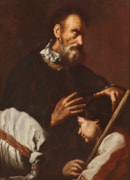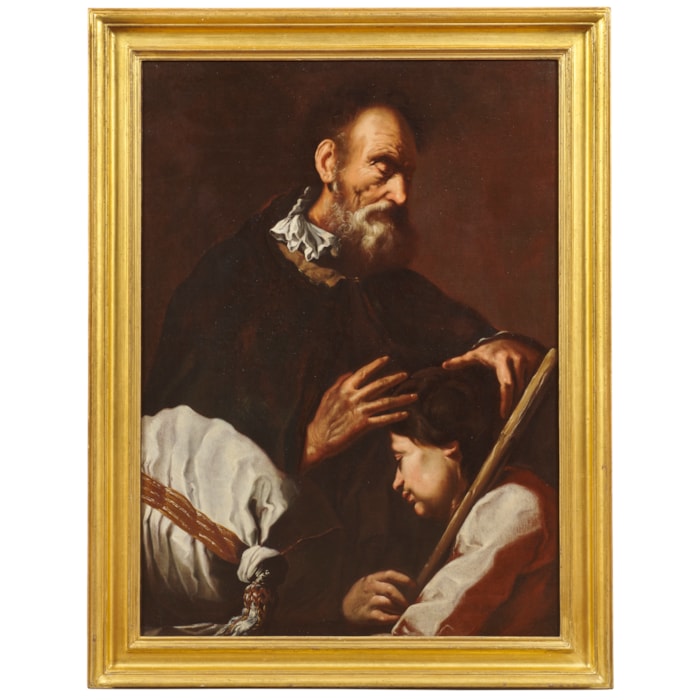Gregorio Preti (Taverna, 1603 - Rome, 1672)
(Taverna, 1603 - Rome, 1672)
The Return of the Prodigal SonOil on canvas, 40½ x 29⅛ in (103 x 74 cm)
- PROVENANCE
- LITERATURE
- EXHIBITIONS
- DESCRIPTION
PROVENANCE
The Marquess of Santa Cruz, who gave this painting – with an attribution to Ribera – to his French surgeon Firmin Recurt in gratitude for his service (he had been his personal physician for 15 years); Firmin Recurt collection (in 1855, Firmin Recurt was created Knight of the Order of Charles III by Queen Isabella II of Spain); by descent to his daughter Anita Recurt de Tomero, at La Colle-sur-Loup; her sale in 1945; France, private collection.
LITERATURE
Unpublished
DESCRIPTION
Gregorio was the older brother of the painter Mattia Preti, who joined him in Rome at the beginning of the 1630s. Most of Gregorio’s career was spent in the Eternal City, where he had occasion to collaborate with Mattia, as seen for example in the Concert with a Scene of “buona ventura” (Turin, Pinacoteca dell’Accademia Albertina), or the ambitious Allegory of the Five Senses (Rome, Gallerie Nazionali di Arte Antica, Palazzo Barberini).
Riccardo Lattuada has ascribed our painting to Gregorio Preti, noting the skilled use of chiaroscuro, which extends to the background, as an illustration of Manfrediana Methodus, the Roman manner of painting of which Gregorio was an enthusiast and disseminator.
The close-up format, on dual levels, enhances the humble attitude of the youth, who has come back to his father seeking forgiveness for his improvident life. The subject illustrates one of the parables of Jesus, narrated in Saint Luke’s Gospel (15: 11-32), in which an old father rejoices at the return of his spendthrift son, while the latter’s brother fails to understand why a paternal pardon should be a cause for such celebration.
Riccardo Lattuada dates our picture to about 1630/1635, and therefore an early work by Gregorio, when the style of each of the Preti brothers was still influential on the other. As regards both style and bearing of the figures, Lattuada compares our Return of the Prodigal Son to the Heraclitus and Democritus in Catanzaro (Amministrazione Provinciale).
A canvas of almost similar composition and size (now in the Galleria dell’Accademia in Venice) was removed from the oeuvre of Domenico Fetti (1589-1623) by Eduard Safarik.1 It can be recalled from a drawing mentioned in that scholar’s catalogue entry that another version existed in the collection of Count Humprecht Jan Czernin in Prague, before 1669.
Note:
1 - Eduard A. Safarik (with the assistance of Gabriello Milantoni), Fetti, Milan, 1990, p. 315, no. A136.










